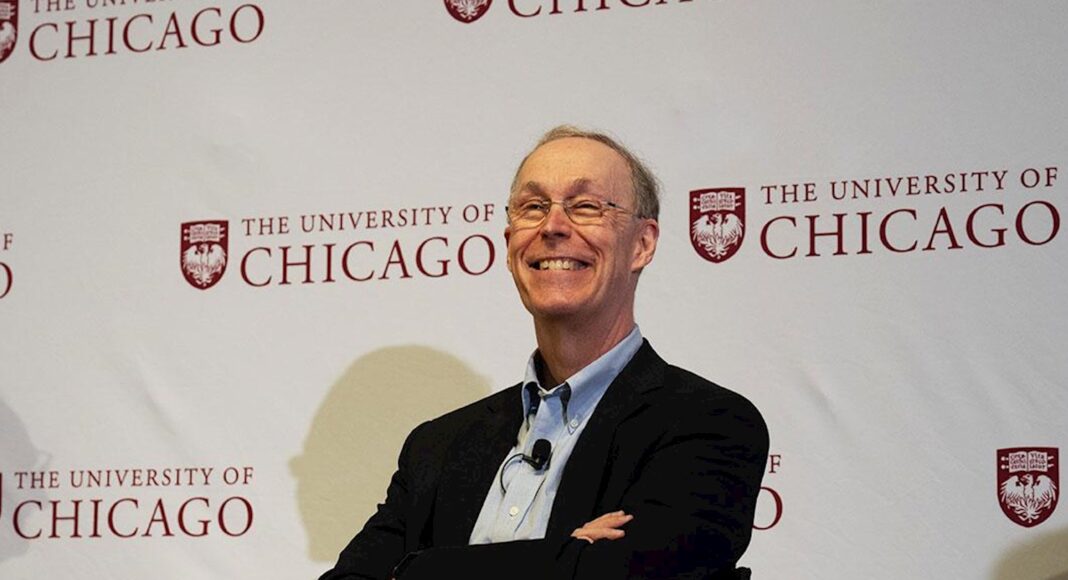Chicago Booth professors Zhiguo He and Yueran Ma discuss their admiration for the work and mentorship of 2022 Nobel winner Douglas Diamond.
The economics community has always admired Professor Douglas Diamond for his deep insights and illuminating creativity, long before the much-awaited and richly deserved announcement that he had won the 2022 Nobel Prize in economics.
Like many faculty members at Chicago Booth, our academic lives started with reading Doug’s papers. As we progressed in our studies, it soon became evident that at the beginning there was Diamond and Dybvig (1983) and Diamond (1984), and then many things followed: optimal contracting in financial markets and institutions, economic analyses of credit cycles, and more broadly, optimal financial regulation, among others. These two influential articles on financial intermediation laid the foundation for modern banking research, with far-reaching influences on many parts of economics and long-lasting impacts on policymaking. They embody the hallmark of good economics: deceitfully simple, yet extremely profound and relevant. Much like his namesake, Professor Diamond condenses much value into little space.
When we reflect on the unifying theme of scholarly achievement by Doug, we can see that his work represents the perfect balance between practical relevance and academic rigor. Doug is a world-renowned theorist, but he also has vast and precise knowledge on how the world functions in practice. He thinks about many real-life issues with penetrating insights about how they are connected by fundamental underlying economic forces. Meanwhile, his work—such as the two articles cited by the Nobel Committee—exemplifies the best of academic rigor. The Diamond-Dybvig model is not simply about showing that bank runs can occur (which could be illustrated with just depositors’ self-serving behavior); the beauty of the paper is to show, at a deeper level, that the systemic fragility is precisely a result of the optimal arrangement that aims to address the individual depositors’ idiosyncratic liquidity need in the first place. This observation reveals the critical trade-off faced by financial regulators. Along a similar vein, Diamond (1984) is not simply about explaining that banks can help depositors monitor loans; it also demonstrates that having deposit-funded financial intermediaries is an optimal solution to the essential problem—“who monitors the monitor?”
At the fall party for Booth faculty several days ago, we had a conversation with Guido Lorenzoni, our colleague at the macroeconomics group, about permanence in economics. Is it the case that the discipline of economics is more transitory than disciplines like mathematics? Where one proves a theory and it remains that way forever? What insights in economics will remain after, say, two hundred years? Guido replied: borrowing and lending; or in other words, financial intermediation. Such an interesting and precise answer, to which we whole heartedly agree.
One way to think about financial intermediation is that there are some people with ideas out there, we need to distinguish the good ideas from the not-so-good ones, and we might delegate screening good ideas to a financial intermediary. In the meantime, the intermediary also transforms complicated things like firms’ assets into simple and transparent things like deposits. As long as human society features separation between ideas and money, Doug’s insights on financial intermediation will guide us for hundreds of years to come.
At Chicago Booth, it is also amazing to observe how Doug has applied the principles of financial intermediation in everyday life, as he performs the critical functions of knowledge intermediation at every seminar. He will start by listening patiently. With incredible speed, he can distinguish good ideas from not-so-good ones and distill the complicated ones into their core essences. He also translates obscure theoretical statements to simple terms, often illustrated with real-life examples. We have learned enormously from his comments in seminars, and we all delegate quite a bit to him for the intermediation of knowledge.
Another basic role of financial intermediaries is to invest in productive projects. There are two insights from Doug’s work. First, investing is not just about collecting a stream of cash flows; in fact, an important function of lenders is to take actions when useful and make the borrowers’ projects better. Second, banks should diversify risk by holding a large portfolio of loans. Doug practices these principles quite a bit in life, being extremely kind, positive, and supportive to everyone including colleagues, staff members, and students from almost all fields and topics. Soon after the announcement of the prize, we received excited text messages from past staff members about the wonderful news. Hundreds gathered in the winter garden to celebrate for him. And, several years ago when we celebrated his 65th birthday at the Fama-Miller Center, there was perfect turnout among Doug’s past PhD students over his 40-year career. When we think about Doug, we often think about light. His positive and uplifting attitude brightens our lives.
Several months ago Doug said that “people–even Gene Fama–appreciate knowing that they are appreciated.” It is wonderful to reflect Doug’s own principle back upon him: people–even Doug Diamond–may appreciate knowing that they are appreciated. It is a tremendous honor to congratulate Doug. Thank you for all the inspiration you have given us, academically and personally.






